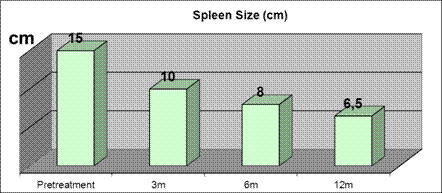Abstract
MF is a myeloproliferative neoplasm characterized by bone marrow fibrosis, splenomegaly, cytopenias and constitutional symptoms. Since the identification of JAK2V617F mutation and development of anti JAK molecules, the course of the disease has changed. Ruxolitinib is a JAK1 and JAK2 inhibitor recently approved for patients (pts) with primary and secondary MF.
In Argentina, pts could access the ruxolitinib through CUP. Analysis of this multicenter protocol provides a preliminary data set, follow up and efficacy results.
To assess the efficacy (reduction in spleen size/improvement in constitutional symptoms) and toxicity. To investigate risk groups modifications during follow-up.
In Argentina, 36 pts with myelofibrosis, including primary MF (PMF) and post polycythemia vera (PPV) received ruxolitinib through CUP regardless of JAK2 mutational status. Study period: September 2011 to June 2013. The participating physicians provided information of the disease characteristics by completing a data form. Splenomegaly was evaluated by physical exam, and constitutional symptoms were categorized as present or absent. Retrospective analysis was performed based on data at baseline (n 36), after 3 months (n 30), 6 months (n 24) and 12 months (n 14).
Median follow-up is 10 months (1-20). The median age is 65 years (30-79), 64% were men and 36% women. There were 72% positive for the JAK2 V617F mutation, 69% had PMF and 31% Post-PV.
At admission 89% of pts had received ≥1 lines of therapy for MF prior to ruxolitinib: hydroxyurea 77%, thalidomide 26%, erythropoietin 23%, others: corticosteroids, interferon, anagrelide, danazol, busulfan, splenic radiation, cytarabine, and 6-mercaptopurine. The distribution of risk category according to DIPSS was: 61% high, 19% Intermediate 2, 17% Intermediate 1, and 3% low. Median value for spleen size was 15 cm (4-33) below the costal margin. Constitutional symptoms were present in 71% of the patients and 33% were transfusion dependent. ECOG (Eastern Cooperative Oncology Group) was zero 28%, one 44%, two 22%, three 3%, and four 3%. The median hemoglobin, leucocytes and platelets was 10 g/dl (4.8-15.2); 13, 4 x 109/L (3.6-64) and 217 x 109/L (75-850), respectively. Peripheral blood blasts ≥ 1% in 44% of pts.
Ruxolitinib therapy was initiated at 40 mg/d in 16 pts (50%), 30 mg/day in 9 pts (28%), and at a lower dose in the minority of pts.
The median value for spleen size at 3, 6 and 12 months was 10, 8 and 6.5 cm, representing decrease of 20%, 41% and 42% from baseline, respectively (fig 1.). In 13 of 29 pts (45%) spleen size decreased ≥ 50% in 3 months. Constitutional symptoms not present at 3, 6 and 12 months in 79%, 100% and 87% of pts, respectively. Improvement in ECOG class was noted in 73%, 69 % and 73% at the above mentioned time points, respectively. Persistence of transfusion dependence at 3, 6 and 12 months was seen in 33, 24 and 27% of the patients.
Hemoglobin median levels during treatment (g/dL): at baseline 10.1, at 3 months 8.5, at 6 months 9.7, and at 12 months 9.5.
During follow-up, 27% pts shifted to a lower risk group, 2 pts (7%) to a higher group due to worsening anemia, and 67% did not change its category.
Hematologic adverse events (AE) were anemia and thrombocytopenia in 8 pts (Grade 1 and Grade 3 according to CTCAE v4.0), 31% of pts required dose adjustment. There were no suspensions of medication because of cytopenia. Others AE > 10% were: headache, musculoskeletal pain, and diarrhea (<G3). Treatment was discontinued in 7 pts (MF progression n= 2, tuberculosis n=1, death n=4 non related to ruxolitinib).
Ruxolitinib is an effective therapy that reduced spleen size and improved constitutional symptoms with an acceptable toxicity profile in this group of pts. During follow up at 12 months, a quarter of pts shifted to a lower risk group. Our data is consistent with previous reports
reduction in the spleen size in centimeters below the costal margin (by palpation)
reduction in the spleen size in centimeters below the costal margin (by palpation)
Barreyro:GSK: Employment. Enrico:Bristol Myers Squibb: Speakers Bureau; Pfizer: Membership on an entity’s Board of Directors or advisory committees; Novartis: Membership on an entity’s Board of Directors or advisory committees. Lanari Zubiaur:Novartis: Membership on an entity’s Board of Directors or advisory committees. Pavlovsky:Novartis: Consultancy. Sackmann:Novartis: Membership on an entity’s Board of Directors or advisory committees. Bengió:Novartis: Member advisory Board Myelofibrosis Other.
Author notes
Asterisk with author names denotes non-ASH members.


This feature is available to Subscribers Only
Sign In or Create an Account Close Modal